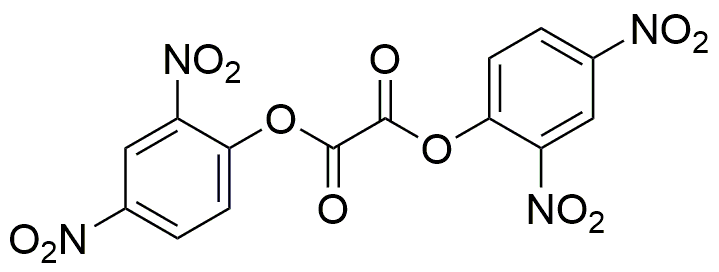Bis(2,4-dinitrophenyl) oxalate is widely utilized in research focused on:
- Explosives Research: This compound serves as a key precursor in the synthesis of various energetic materials, making it valuable for developing safer and more efficient explosives.
- Analytical Chemistry: It is used as a reagent in the detection and quantification of certain metal ions, aiding researchers in environmental monitoring and quality control in manufacturing.
- Pharmaceutical Development: The compound plays a role in drug formulation processes, particularly in the development of new therapeutic agents that require precise chemical properties.
- Polymer Chemistry: It is utilized in the synthesis of polymers with specific characteristics, enhancing the performance of materials used in coatings and adhesives.
- Educational Purposes: This chemical is often used in academic laboratories to demonstrate principles of organic synthesis and reaction mechanisms, providing students with hands-on experience.
Información general
Propiedades
Seguridad y normativas
Aplicaciones
Bis(2,4-dinitrophenyl) oxalate is widely utilized in research focused on:
- Explosives Research: This compound serves as a key precursor in the synthesis of various energetic materials, making it valuable for developing safer and more efficient explosives.
- Analytical Chemistry: It is used as a reagent in the detection and quantification of certain metal ions, aiding researchers in environmental monitoring and quality control in manufacturing.
- Pharmaceutical Development: The compound plays a role in drug formulation processes, particularly in the development of new therapeutic agents that require precise chemical properties.
- Polymer Chemistry: It is utilized in the synthesis of polymers with specific characteristics, enhancing the performance of materials used in coatings and adhesives.
- Educational Purposes: This chemical is often used in academic laboratories to demonstrate principles of organic synthesis and reaction mechanisms, providing students with hands-on experience.
Documentos
Hojas de datos de seguridad (HDS)
La SDS proporciona información de seguridad completa sobre la manipulación, el almacenamiento y la eliminación del producto.
Especificación del producto (PS)
La PS proporciona un desglose completo de las propiedades del producto, incluida la composición química, el estado físico, la pureza y los requisitos de almacenamiento. También detalla los rangos de calidad aceptables y las aplicaciones previstas del producto.
Certificados de análisis (COA)
Busque certificados de análisis (COA) ingresando el número de lote del producto. Los números de lote y de partida se pueden encontrar en la etiqueta de un producto después de las palabras "Lote" o "Lote".
Número de catálogo
Número de lote/lote
Certificados de origen (COO)
Este certificado de origen confirma el país en el que se fabricó el producto y también detalla los materiales y componentes utilizados en él y si se deriva de fuentes naturales, sintéticas u otras fuentes específicas. Este certificado puede ser necesario para cumplir con las normativas aduaneras, comerciales y regulatorias.
Número de catálogo
Número de lote/lote
Hojas de datos de seguridad (HDS)
La SDS proporciona información de seguridad completa sobre la manipulación, el almacenamiento y la eliminación del producto.
DownloadEspecificación del producto (PS)
La PS proporciona un desglose completo de las propiedades del producto, incluida la composición química, el estado físico, la pureza y los requisitos de almacenamiento. También detalla los rangos de calidad aceptables y las aplicaciones previstas del producto.
DownloadCertificados de análisis (COA)
Busque certificados de análisis (COA) ingresando el número de lote del producto. Los números de lote y de partida se pueden encontrar en la etiqueta de un producto después de las palabras "Lote" o "Lote".
Número de catálogo
Número de lote/lote
Certificados de origen (COO)
Este certificado de origen confirma el país en el que se fabricó el producto y también detalla los materiales y componentes utilizados en él y si se deriva de fuentes naturales, sintéticas u otras fuentes específicas. Este certificado puede ser necesario para cumplir con las normativas aduaneras, comerciales y regulatorias.

